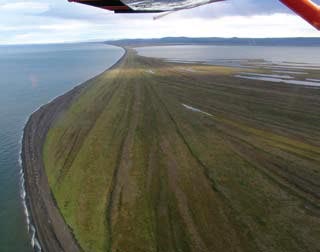
Shelby Anderson
While natural scientists track environmental change in response to global warming, less attention has been directed towards human interface with long term Arctic environmental dynamics. Current research at Cape Krusenstern, Alaska, seeks to address this deficit through investigation of human-environmental interactions recorded in archeological and paleoenvironmental data spanning the last 4,000-5,000 years at the Cape, building on the pioneering work conducted at Krusenstern by J. Louis Giddings and Douglas D. Anderson. Systematic survey and use of new mapping technology to record cultural and natural features are methods central to addressing these research questions. Discovery of new archeological features indicates occupation of the Cape was more extensive over the last 1,000 years than previously thought, although additional fieldwork and analysis are needed.
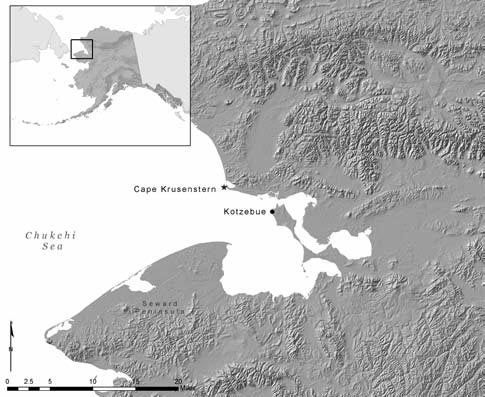
Introduction
Global warming is dramatically impacting the Arctic, bringing about fundamental changes in human lifestyles. This is apparent in countless scientific studies and the testimony of life-long arctic residents (Hassol 2004, Krupnik et al. 2002). While natural scientists strive to track earth systems changes in response to the rapidly evolving environment, less attention has been directed at understanding human interface with long-term dynamics of environmental change in the Arctic. This research seeks to address this deficiency through an investigation of human-environ-mental interactions recorded in archeological and paleoenvironmental data spanning the mid-to-late Holocene in Northwest Alaska. The goal is to better understand the dynamics linking human and environmental systems in Northwest Alaska and to assess the critical factors that limit or enhance cultural vulnerability and resilience to environmental change in the north.
To achieve these goals, the University of Washington (UW) and the National Park Service (NPS) are currently engaged in a multi-year interdisciplinary research project at Cape Krusenstern National Monument in Northwest Alaska (Figure 2). In 2006, the NPS led an archeological field project at Krusenstern, and in 2008 UW carried out the first of three additional field seasons that will continue through the summer of 2010. This research seeks to build on the pioneering work of J.Louis Giddings and Douglas D. Anderson (1986) by conducting the first systematic survey of the beach ridge complex and through the use of new mapping technology to precisely record cultural and natural features. Numerous new radiocarbon dates will be obtained as part of this effort to build on and refine existing archeological data sets from Cape Krusenstern. Synthesis of new, high resolution paleoenvironmental and archeological data collected at Krusenstern will help address long-standing questions about the relationship between local and regional environmental change and past human lifeways. Fieldwork is ongoing, but preliminary findings suggest occupation of the Cape was more extensive over the last 1,000 years than previously thought; numerous previously unknown archeological features were identified in 2008 on beach ridges dating to this time period. Additional fieldwork and analysis is neces-sary to better understand how new data may alter existing understanding of settlement patterns at Krusenstern, but the work conducted to date illustrates the potential of Cape Krusenstern archeology in answering long-standing questions about human-environmental interactions in the Arctic.
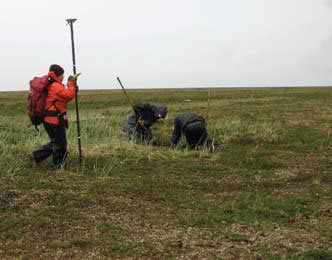
Shelby Anderson
A Unique Paleoenvironmental and Archeological Landscape
The beach ridge complex located at Cape Krusenstern is an ideal place to address questions about archeological and paleoenvironmental change over time. The Krusenstern beach ridge complex is the most extensive in Northwest Alaska, encapsulating over 4,000 years of human occupation as well as a record of past coastal environments (Mason and Jordan 1993). Beach ridges at Krusenstern develop during decade-to century-long periods of fair weather and are eroded during periods of coastal storminess. The approximately 9,000-acre complex contains over 70 distinct beach ridges, forming a ‘horizontal stratigraphy’ with archeological remains progressively older inland (Figure 1). The beach ridges themselves are a record of fluctuating sea level, wave energy and wave direction as the beach ridge complex formed during the mid-to-late Holocene. Human occupation of the Cape spans from approximately 4,000 years ago to the present, encapsulating numerous cultural traditions and recording important changes in subsis-tence, settlement, and socioeconomic organization that occurred throughout the region (Giddings and Anderson 1986, Harritt 1994, Schaaf 1988). A rich ethnographic and ethnohistoric record (Burch 1998) indicates close connection between cultural organization and environmental variability in the more recent past, suggesting that human-environmental dynamics were important throughout pre-history.
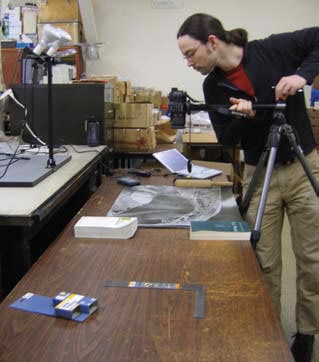
Shelby Anderson
Methods
Archeological field methods are directed at systematically collecting samples and spatial data across the beach ridges, as well as precisely mapping relationships between archeological and environmental features for the first time. Use of high precision, high accuracy Global Positioning System (GPS) units to collect spatial data is central to gathering the data needed to address project research questions. GPS technology allows rapid recording of feature size, shape and condition information as field crews survey and test the beach ridge complex (Figure 3). Trimble GeoXH and ProXH units used with Zephyr antennas can be accurate to within 8 inches (20 cm) after data postprocessing. The challenge of connecting archeological sites with specific beach ridges is a critical, and until recently, very difficult aspect of conducting fieldwork at Krusenstern. New high resolution orthorecti-fied imagery for the area (Manley et al. 2007), along with GPS and Geographic Information System (GIS) technology, make this task much simpler. The project GIS combines GPS spatial data with site condition and collections information, making the GIS a useful research and management tool.
Integrating data from previous archeological work at Krusenstern is an important component of the research. To achieve this, Giddings’ original spatial data was collected from two annotated aerial photomosaics, which were imported into the project GIS and georeferenced (Figure 4). Archeological features marked on the photos were digitized and the spatial placement of each feature location cross checked with orthographic imagery. While site locations generated through this process are not always precise, this provides the information needed in the field to determine whether or not a feature was recorded previously. Most importantly, it is now possible to connect existing dates and excavation data with specific features, which are in the process of being rerecorded and incorporated into the project GIS along with new archeological data.
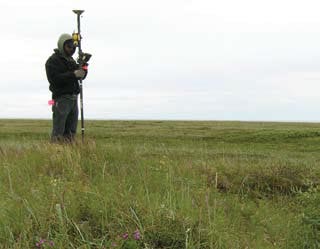
Nicholas Radko
2006 and 2008 Field Seasons: Preliminary Findings
It is estimated that over 600 archeological sites and features were identified on the beach ridge complex before 2006. These sites were primarily recorded by Giddings and his students who worked at Krusenstern in the late 1950s to early 1960s. The NPS, however, estimates that before 2006, the beach ridge complex was only approximately 30% surveyed. Considerable potential exists for new archeological discoveries and the results of the first two seasons of field work support this. In addition to previously reported and excavated features, numerous previously undocumented features were recorded in 2006 and 2008 (Figure 5). To date, approximately 2,400 acres of the beach ridge complex have been systematically surveyed and over 1,280 archeological features have been recorded by the current project. Many of these newly recorded features are smaller house or storage features that are not as densely clustered as the large settlements that were the focus of previous investigations. Although new features were recorded in survey areas across the beach ridge complex, many of these features date to the last 1,000 years.
In addition to survey and mapping activities, several site areas were tested in 2006 and 2008 (Figure 6) in order to collect well provenienced samples for dating and other analyses (Figure 7). A total of 19 radiocarbon dates were obtained in 2006, and dating yielded ages from 6420 BP to 280 BP (before present). The 6420 BP date is likely due to accidental sampling of old wood, as the beach ridges themselves did not begin to form until sea level stabilized in the region between 5,000 and 4,500 years ago. Additional samples from the 2008 field season will be submitted for dating in winter 2009.
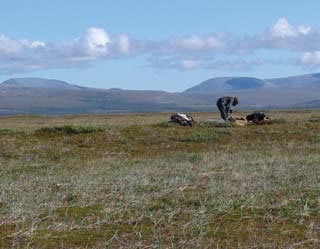
Shelby Anderson
Discussion
Previous settlement reconstructions indicate that population increased at Krusenstern until about 500 years ago, based on the number and density of house features, and then decreased after this time as people dispersed, perhaps to focus on different resources (Anderson 1984). This pattern at Krusenstern is in contrast to that known for other large settlements around Kotzebue Sound, such as Point Hope and Wales, where population continued to increase over the last 500 years (Mason 1998). Perhaps this is because people continued to have access to whales and other large marine mammals in these other locations while people living at Krusenstern did not (Anderson 1984). New survey information, particularly for the last 1,000 years, will be important in re-evaluating existing settlement models and population estimates for Krusenstern. Reconsidering Krusenstern’s place in the regional socio-political sphere in light of this settlement data may also yield interesting results. Additional survey data and radiocarbon dating will provide information on the timing and nature of changes in settlement densities, as well as data on house size and configuration that may indicate changes in social organization at Krusenstern.
In addition to addressing our research questions, the data generated by this project is important for NPS resource management purposes. The integration of old and new archeological data into a GIS will make it easier for NPS archeologists to fully utilize project findings and share information with other park staff. The incorporation of legacy data into the project GIS means that as fieldwork continues, current feature condition can be compared to that recorded by Giddings 50 years ago. Long-term data on site condition is important for understanding future po-tential impacts to archeological sites at the Cape.
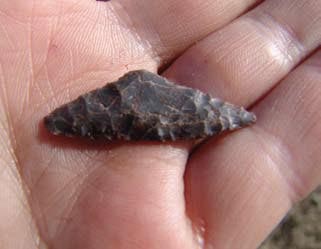
Shelby Anderson
Summary and Conclusions
At Cape Krusenstern we have the opportunity to undertake a comprehensive study of past human and environment interactions in a place where human occupation appears to be nearly continuous over the last 4,000+ years. Previous research at Krusenstern has provided a strong framework for integrating archeological and paleoenvironmental research through this new study. With new tools like high resolution GPS, the beach ridge complex can be systematically surveyed, mapped, and sampled for the first time. Findings to date show interesting patterns in settlement size and density, and illustrate how questions about changing settlement, demography, and mobility will be addressed through additional fieldwork and analysis. An improved chronology for the occupation at Krusenstern will also have regional level implications.
In the 2009 and 2010 field seasons, fieldwork will be focused on testing to gather more samples for dating and analysis from features across the beach ridge complex, although the survey and mapping effort will continue as well. Given the important place of Krusenstern in our understanding of regional cultural evolution, the new archeological and paleoenvironmental research carried out at Krusenstern will be relevant to research in both fields across greater Beringia. More information about the project is available on the website: http://students.washington.edu/shelbya/CAKR_Project.shtml
Acknowledgements
The support and contributions of the follow-ing people have made this project possible: the 2006 and 2008 field crews, Eileen Devinney, Robert Gal, Sabra Gilbert-Young, Chris Young, Douglas Anderson, and Joel Cusick. We would also like to thank the Cape Krusenstern community and NPS Western Arctic National Parklands staff.
References
Anderson, Douglas D. 1984.
Prehistory of North Alaska. In Arctic: Handbook of North American Indians, vol. 5, edited by D. Damas, W.C. Sturtevant, general editor, 80-93. Smithsonian Institution Press. Washington D.C.
Burch, E.S., Jr. 1998.
The Iñupiaq Nations of Northwest Alaska. University of Alaska Press. Fairbanks, AK.
Giddings, J.L., and Douglas D. Anderson. 1986.
Beach Ridge Archeology of Cape Krusenstern: Eskimo and Pre-Eskimo Settlements around Kotzebue Sound, Alaska. Publications in Archeology, 20. National Park Service. Washington D.C.
Harritt, Roger K. 1994.
Eskimo Prehistory on the Seward Peninsula. Alaska Region Resources Report NPS/ ARORCR/CRR-93/21. National Park Service. Anchorage, AK.
Hassol, Susan J. 2004.
Impacts of a Warming Arctic: Arctic Climate Impact Assessment. Cambridge University Press. Cambridge, U.K (http://www.acia.uaf.edu)
Krupnik, I., and D. Jolly, eds. 2002.
The Earth is Faster Now: Indigenous Observations of Arctic Environmental Change. Arctic Resource Consortium of the United States. Fairbanks, AK.
Manley, William F., D.M. Sanzone, L.R. Lestak, and E.G. Parrish. 2007.
High-Resolution Orthorectified Imagery for the Coastal Areas of Bering Land Bridge National Park and Cape Krusenstern National Monument, Northwest Alaska. National Park Service, Arctic Network Inventory and Monitoring Program. Fairbanks, AK (http://instaar.colorado.edu/QGISL/ARCN)
Mason, Owen K. 1998.
The Contest between the Ipiutak, Old Bering Sea, and Birnirk Polities and the Origin of Whaling during the First Millennium A.D. along Bering Strait. Journal of Anthropological Archeology 17(3): 240-325.
Mason, Owen. K., and Jim W. Jordan. 1993.
Heightened North Pacific Storminess and Synchronous late Holocene Erosion of Northwest Alaska Beach Ridge Complexes. Quaternary Research 40(1): 55-69.
Schaaf, Jeanne, editor. 1988.
The Bering Land Bridge: An Archeological Survey. Alaska Region Research/Resources Management Report AR-14. National Park Service. Anchorage, AK.
Part of a series of articles titled Alaska Park Science: Volume 8, Issue 2: Park Science in the Arctic.
Last updated: July 20, 2022
